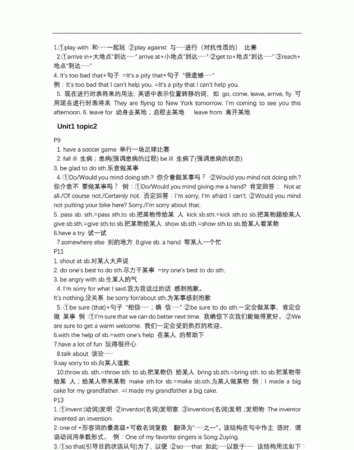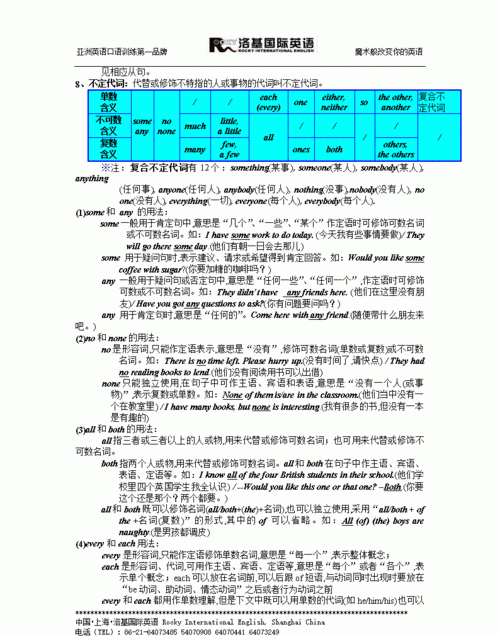本文目录
英语的基本知识点总结
学习知识的最终目的是将知识灵活运用到现实生活、学习中,学中用、用中学是学习知识的一个重要原则,英语词汇学习亦如此。那英语的基础知识都有哪些呢?下面我给你分享英语的基本知识点,欢迎阅读。
英语的基本知识点【1】
名词的变化规律
1. 一般情况下加s (如cats, dogs, friends, books, papers等)
2. 以s, x, ch, sh 结尾的加es (如buses, boxes, matches, flashes等)
3. 以辅音字母+y 结尾的名词,把y 改为i 再加es (如ladies, stories, candies等) 但要注意的是以元音字母加y结尾的名词的复数形式只加s,如:boy→boys, day→days。
4. 部分以o 结尾的名词,有生命的加es, 没生命的加s (如potatoes, tomatoes, photos, pianos等),以oo 结尾一般情况下加s (如zoo, kangaroo等)
5. 以f 或fe 结尾的名词,多把f 或fe 改为v再加es (如knives, shelves, leaves等)
(7)少数名词有不规则的复数形式,例如:man→men,woman→women,tooth→teeth,foot→feet,child→children,mouse→mice。
【注意】与man和woman构成的合成词,其复数形式也是-men和-women。例如:an Englishman,two Englishmen。但German不是合成词,故复数形式为 Germans;man, woman等作定语时,它的单复数以其所修饰的名词的单复数而定,如:men workers, women teachers。
有个别名词单复数一样,例如:Chinese,Japanese,sheep,deer,fish等。但当fish表示不同种类的鱼时,可以加复数词尾。
复数词尾s(或es)的读音方法
1、在[p][t][k][f]等清辅音后读[s] ,如cups, hats, cakes。
2、在[s][z][t][ ][f]等音后读[iz],如glasses, pages, oranges, buses, watches,faces。
3、在[b][d][ g][v]等浊辅音后读[z],如beds, dogs, cities, knives。
英语的基本知识点【2】
动词各种时态的变化
一、动词三单形式的变化规律
1. 直接在动词后加s ,如want—wants, work—works, know—knows, help—helps,get—gets。
2. 以s, x, ch, sh 结尾的动词在后面加es ,如watch—watches,catch—catches。
3. 以辅音字母加o 结尾加es ,如go—goes,do—does。
4. 以辅音字母加y 结尾,把y 改为i 再加es ,如study—studies,carry—carries,fly—flies,worry—worries
5. 以元音字母加y 结尾,直接加s ,如play—plays.
6. 不规则变化
二、动词ing 的变化规律:
1.英语动词加-ing,通常是在原形词尾直接加-ing构成:cough—coughing,climb—climbing,stand—standing,fight—fighting
2.以-e结尾的动词
(1)如果动词原形以一辅音加一不发音的-e结尾,一般应去掉e再加ing:
write—writing,hope—hoping,care—caring,stare—staring,plane—plan-ing,have—having,save—saving, produce—producing, breathe—breathing (2)以-ie结尾的动词应先将e去掉,将i变成y然后再加-ing: die—dying,tie—tying,vie—vying,lie—lying
(3)以-ee,-oe,-ye结尾的动词加-ing时应保留词尾e:
see—seeing,flee—fleeing,free—freeing,agree—agreeing,hoe—hoeing, dye—dyeing,eye—eyeing
(4)以-ue结尾的动词大多应先去e再加-ing:
sue—suing,imbue—imbuing,construe—construing,pursue—pursuing,rue—ruing 有时,词尾e可去掉也可保留: glue—gluing或 glueing,cue—cuing或 cueing, blue—blueing或 bluing, true—truing或trueing,clue—clueing或cluing
3.以一元音加一辅音结尾的动词
(1)如果动词最后一音节为重读闭音节,最后一个字母需要重复:
run—running, stop—stopping, hop—hopping, plan—planning,star—starring, control—controlling但辅音x是个例外,无需重复(x其实起着两个辅音的作用): tax—taxing,relax—relaxing
(2)如果动词最后一个音节为次重读音节,最后一个字母有时也重复: kidnap—kadnapping或kidnaping,program—programming或programing
(3)如果动词最后一个音节为非重读音节,最后一个字母大多无需重复:
open—opening,offer—offering,audit—auditing但在有些动词中,重复或不重复均可: worship—worshiping或 worshipping,focus—focusing或 focussing,cancel—canceling或cancelling,travel—traveling或travelling
以非重读的-el结尾的动词加-ing时,英国英语习惯于重复词尾l,而美国英语则习惯于不重复1。
4.若动词以一元音加一半元音(y或w)结尾,可直接加-ing:
pay—paying, throw—throwing,follow—following, draw—drawing, em-ploy—employing
5.以-ic结尾的动词应先在字母c后加一字母k再加-ing:
frolic—frolicking,panic—panicking,mimic—mimicking,picnic—picnicking,traffic—trafficking
三、动词过去式的变化规律:
1.一般在动词末尾加-ed,如:pull-pulled, cook-cooked
2.结尾是e加d,如:taste-tasted
3.末尾只有一个元音字母和一个辅音字母的重读闭音节,应双写末尾的辅音字母,再加-ed,如:stop-stopped
4.以“辅音字母+y”结尾的,变y为i, 再加-ed,如:study-studied
5.不规则动词过去式:
am,is-was are-were do-did see-saw say-said
give-gave get-got go-went come-came have-had
eat-ate take-took run-ran sing-sang put-put
make-made read-read write-wrote draw-drew
drink-drank fly-flew ride-rode speak-spoke
sweep-swept swim-swam sit-sat
形容词比较级
1、一般在词尾加er 如long变为longer
2、以不发音的字母e结尾的加r 如late变为leter
3、以重读闭音节结尾的词,而词尾只有一个辅音字母时,先双写这一辅音字母,再加er 如hot变为hotter
4、以辅音字母加y结尾的双音节词先变y为i再加er 如happy变为happier 多音节词在词前加more 如quickly变为more quickly
另外还有一些不规则变化 如good变为better many变为more 这类问题要注意积累 一般在词尾加er 如long变为longer 。

基础英语知识点句型和语法
基础英语知识点大全
在我们平凡的学生生涯里,相信大家一定都接触过知识点吧!知识点就是一些常考的内容,或者考试经常出题的地方。那么,都有哪些知识点呢?下面是我收集整理的基础英语知识点,欢迎阅读与收藏。

第一部分、基础知识
1.字母:26个字母的大小写
大写:ABCDEFGHIJKLMNOPQRSTUVWXYZ
小写:abcdefghijklmnopqrstuvwxyz
2.语音:元音的发音 五个元音字母:AEIOU
12个单元音:长元音:/ɑ:/,/ :/,/ :/, /i:/,/u:/
短元音:/ / /e/ /i/ / / /∧/ /u/ / /
3.词汇:词汇量,近反义词
4.句子:大小写,标点符号
第二部分、语法知识
一、名词:名词单复数,名词的格
(一)名词单复数
1.一般情况,直接加-s,如:book-books, bag-bags, cat-cats, bed-beds
2.以s. x. sh. ch结尾,加-es,如:bus-buses, box-boxes, brush-brushes, watch-watches
3.以―辅音字母+y‖结尾,变y为i, 再加-es,如:family-families, strawberry-strawberries
4.以―f或fe‖结尾,变f或fe为v, 再加-es,如:knife-knives
5.不规则名词复数:
man-men,
woman-women,
policeman-policemen,
policewoman-policewomen, mouse-mice
child-children,
foot-feet,
tooth-teeth,
fish-fish,
people-people,
Chinese-Chinese,
Japanese-Japanese
不可数名词的复数就是原型: paper, juice, water, milk, rice, tea
(二)名词的格
1.有生命的东西的名词所有格:
(1) 单数后加 ‘s 如: Lucy‘s ruler my father‘s shirt
(2)以s 结尾的复数名词后加 ‘如: his friends‘ bags
(3)不以s 结尾的复数后加 ‘s children‘s shoes
并列名词中,如果把 ‘s加在最后一个名词后,表示共有;
如:Tom and Mike‘s car 汤姆和迈克共有的小汽车
表示所有物不是共有的,应分别在并列名词后加‘s.
如:Tom‘s and Mike‘s cars 汤姆和麦克各自的小汽车
2.表示无生命东西的名词通常用― of +名词‖来表示所有关系:
如:a picture of the classroom a map of China
二、冠词:不定冠词,定冠词种类:
(一) 不定冠词:a / an
元音读音开头的`可数名词前用an :
an egg / an apple / an orange / an eraser / an answer / an ID card / an alarm clock / an actor / an actress / an e-mail / an address / an event / an example / an opera / an hour an old man / an interesting book / an exciting sport / an action movie / an art lesson /
(二)定冠词:the
定冠词的用法:
1.特指某(些)人或某(些)物: The ruler is on the desk.
2.复述上文提到的人或物:He has a sweater. The sweater is new.
3.谈话双方都知道的人或物:The boys aren‘t at school.
4.在序数词前: John‘s birthday is February the second.
5.用于固定词组中: in the morning / afternoon / evening 不用冠词的情况:
(1)专有名词前:China is a big country.
(2)名词前有定语:this , that , my , your , some, any , no 等:
This is my baseball.
(3)复数名词表示一类人和事:Monkeys can‘t swim. They are teachers.
(4)在节日,日期,月份,季节前:Today is Christmas Day. It‘s Sunday.
(5)一日三餐前:We have breakfast at 6:30.
(6)球类 棋类运动前:They often play football after class. He plays chess at home. * 但乐器前要用定冠词:I play the guitar very well.
(7)学科名称前:My favorite subject is music.
(8)在称呼或头衔的名词前:This is Mr Li.
(9)固定词组中:at noon at night by bus
三、形容词,副词:比较级,最高级
(一)、形容词的比较级
1、形容词比较级在句子中的运用:两个事物或人的比较用比较级,比较级后面一般带有单词than。比较级前面可以用more, a little来修饰表示程度。than后的人称代词用主格(口语中可用宾格)。
2.形容词加er的规则:
⑴ 一般在词尾加er ;
⑵ 以字母e 结尾,加r ;
⑶ 以一个元音字母和一个辅音字母结尾,应双写末尾的辅音字母,再加er ;
⑷ 以―辅音字母+y‖结尾,先把y变i,再加er 。
3.不规则形容词比较级:
good-better, beautiful-more beautiful
(二)副词的比较级
1.形容词与副词的区别 (有be用形,有形用be;有动用副,有副用动) ⑴在句子中形容词一般处于名词之前或be动词之后 ⑵副词在句子中最常见的是处于实义动词之后
2.副词比较级的变化规则基本与形容词比较级相同 (不规则变化:well-better, far-farther)
四、 数词:基数词,序数词
(一)基数词
1.1-20
one,two,three,four,five,six,seven,eight,nine,ten,eleven,twelve,thirteen,fourteen,fifteen, sixteen,seventeen,eighteen,nineteen,twenty
2.21-99
先说―几十‖,再说―几‖,中间加连字符。
23→twenty-three,34→thirty-four,45→forty—five,56→fifty-six,67→sixty-seven,78→seventy-eight,89→eighty-nine,91→ninety-one
3.101—999
先说―几百‖,再加and,再加末两位数或末位数;
586→five hundred and eighty-six,803→eight hundred and three
4.l,000以上,先从右往左数,每三位数加一个―,‖,第一个―,‖前为thousand.第二个―,‖前为million,第三个―,‖前为billion 1,001→one thousand and one
18,423→eighteen thousand,four hundred and twenty-three
6,260,309→six million two hundred and sixty thousand three hundred and nine 750,000,000,000→seven hundred and fifty billion
(二)序数词
1.一般在基数词后加th
eg.four→fourth,thirteen→thirteenth
2.不规则变化
one→first,two→second,three→third,five→fifth,eight→eighth,nine→ninth,twelve—twelfth
3.以y结尾的十位整数,变y为ie再加th
twenty→twentieth, forty→fortieth, ninety→ninetieth
4.从二十一后的―几十几‖直至―几百几十几‖或―几千几百几十几‖只将个位的基数词变为序数词。
twenty-first,two hundred and forty-fifth 基数词转为序数词的口诀: 基变序,有规律,词尾加上-th.
一,二,三,特殊记,词尾字母t,d,d. 八去t,九去e, ve要用f替。 ty将y变成i,th前面有个e.
若是碰到几十几,前用基来后用序。
五、介词:常用介词:in, on, at, behind等
(一).at表示时间概念的某一个点。(在某时刻、时间、阶段等)。
at 1:00(dawn,midnight,noon)在一点钟(黎明、午夜、中午)
(二).on表示具体日期。
注:(1)关于"在周末"的几种表示法:
at(on)the weekend在周末---特指
at(on)weekends在周末---泛指
over the weekend在整个周末
during the weekend在周末期间
(2)在圣诞节,应说at Christmas而不说on Christmas
(3)在(刚……)的时候。
On reaching the city he called up his parents. 一到城里他就给父母打了一个电话。
(三).in.表示"时段"、"时期",在多数情况下可以和during互换,前者强调对比,后者强调持续。 in(during)1988(December,the 20th century)在一九八八年(十二月、二十世纪)
六、动词:
动词的四种时态:
(一)一般现在时:
一般现在时的构成
1.be动词:主语+be(am, is, are)+其它。如: I am a boy. 我是一个男孩。
2. 行为动词:主语+行为动词(+其它)。 如: We study English. 我们学习英语。 当主语为第三人称单数(he, she, it)时,要在动词后加"-s"或"-es"。如:Mary likes Chinese.玛丽喜欢汉语。 动词+s的变化规则
(1)一般情况下,直接加-s,如:cook-cooks, milk-milks
(2)以s. x. sh. ch. o结尾,加-es,如:guess-guesses, wash-washes, watch-watches, go-goes 3.以―辅音字母+y‖结尾,变y为i, 再加-es,如:study-studies
(二)一般过去时:
动词过去式详解 动词的过去式的构成规则有:
1.、规则动词
① 一般直接在动词的后面加ed:如 worked , learned , cleaned , visited
② 以e结尾的动词直接加d:如 lived , danced , used
③ 以辅音字母加y结尾的动词要改y为i再加ed(此类动词较少)如 study – studied carry
– carried worry – worried (注意play、stay不是辅音字母加y,所以不属于此类)
④ 双写最后一个字母(此类动词较少)如 stopped B、不规则动词(此类词并无规则,须熟记)小学阶段要记住以下动词的原形和过去式:sing – sang , eat – ate ,
see – saw , have – had , do – did , go – went , take – took , buy – bought , get – got , read – read ,fly – flew , am/is – was ,
are – were , say – said , leave – left , swim – swam , tell – told , draw – drew , come – came , lose – lost , find – found , drink – drank , hurt – hurt , feel – felt
(三)一般将来时: 基本结构:
①be going to + do;
②will+ do. be going to = will I am going to go swimming tomorrow(明天). = I will go swimming tomorrow.
(四)现在进行时: am,is,are+动词现在分词
动词现在分词详解 动词的ing形式的构成规则:
① 一般的直接在后面加上ing , 如doing , going , working , singing , eating
② 以e 结尾的动词,要先去e再加ing ,如having , writing
③ 双写最后一个字母的(此类动词极少)有:running , swimming , sitting , getting
第三部分、句 法
一、陈述句
(一)肯定句:是指用肯定的语气来陈述的句子,如:I‘m a student. She is a doctor. He works in a hospital.
There are four fans in our classroom. He will eat lunch at 12:00. I watched TV yesterday evening.
(二)、否定句:含有否定词或表示否定意义词的句子,如:I‘m not a student. She is not(isn‘t) a doctor.
He does not (doesn‘t) work in a hospital. There are not (aren‘t) four fans in our classroom. He will not (won‘t) eat lunch at 12:00. I did not (didn‘t) watch TV yesterday evening.
二. 疑问句
(二)特殊疑问句:以特殊疑问词(what , where , who , which , when , whose , why , how等)开头引导的句子。此类句子应该问什么就答什么,不能用―yes 、no‖来回答。
(三)There be句型
There be 句型与have, has的区别:
1、There be 句型表示:在某地有某物(或人)
2、在there be 句型中,主语是单数,be 动词用is 主语是复数,be 动词用are 如有几件物品,be 动词根据最*近be 动词的那个名词决定。
3、there be 句型的否定句在be 动词后加not , 一般疑问句把be 动词调到句首。
4、there be句型与have(has) 的区别:there be 表示在某地有某物(或人);have(has) 表示某人拥有某物。
5、some 和any 在there be 句型中的运用:some 用于肯定句, any 用于否定句或疑问句。
6、and 和or 在there be句型中的运用:and 用于肯定句, or 用于否定句或疑问句。
7、针对数量提问的特殊疑问句的基本结构是:
How many + 名词复数 + are there + 介词短语? How much + 不可数名词 + is there + 介词短语 ?
8、针对主语提问的特殊疑问句的基本结构是: What‘s + 介词短语?
;英语语法基础知识点
英语语法基础知识点
英语语法是针对 英语语言进行研究后,系统地总结归纳出来的一系列语言规则。以下是我整理的关于英语语法基础知识点,希望大家认真阅读!

1.as...as...引导的比较级:
(1)“as +形容词或副词原级+as+被比较对象”结构。例句: He studies as hard as you. 他像你一样学习努力。
(2)在否定句或疑问句中可用 not so…as…. 例句:He can notrun so/as fast as you. 他没你跑得快。
2.only引导的倒装句型:only +状语 (或状语从句)位于句首时,句子部分倒装。
例句: Only by diligence and honesty can one succeed inlife. 只有勤奋、正直,一个人在生活中才能成功。
注意:但 only修饰主语时,不倒装。例句: Onlythat girl knew how to work out the problem. 只有那位女生知道怎样解那道题。
3.wish引导的虚拟语气:wish 后面的从句,当表示与事实相反的情况,或表示将来不太可能实现的愿望时,其宾语从句的动词形式为:
⑴表示对现在情况的虚拟:从句动词用过去式或过去进行式表示,be 的过去式用were.
I wish I knew the answer to the question. 我希望知道这个问题的答案。(可惜不知道。)
⑵表示对过去情况的虚拟:从句动词用had +过去分词。
I wish (that) I hadn’t wastedso much time. 我后悔不该浪费这么多时间。( 实际上已经浪费掉了。)
⑶表示对将来的主观愿望:谓语动词形式为“would/ should/ could/ might +动词原形”。在这种情况下,主句的主语与从句的主语不能相同,因为主句的.主语所期望的从句动作能否实现,取决于从句主语的态度或意愿(非动作名词除外) 。
I wish it would stop raining. 但愿雨能停止。
注意:若wish 后的宾语从句中用 would,可以表示请求,通常意味着说话人的不快或不满。
例句:I wish you would be quiet. 我希望你安静一些。
4.it形式宾语:和it 作形式主语一样, 我们常用it 来作形式宾语, 把真正的宾语从句放在句末, 这种情况尤其出现在带复合宾语的句子中。
例句:He has made it clear that he will not give in. 他表明他不会屈服。
5.The+比较级,the+比较级表示“越......越......”。
例句:The more scared we are, the stronger the difficultywill become.我们越害怕困难,困难就会变得越强大。
6. 宾语从句:一般疑问句做宾语,引入if或whether
例句: I want to know if he will join us in thediscussion?
7. 原因状语从句:since引导的
例句: Don’t eat too much sugarsince it is bad for your health.
8. 否定词前置倒装:scarcely...when...
例句: Scarcely had he arrived at home when it began torain.
9. If虚拟条件句
10. 宾语从句:放在介词后面,作介词的宾语。
例句:I know nothing about him except that he used towork in Shanghai.
11.状语从句省略(分词作状语):从句的主语和状语从句的主语一致,状从省略采用分词作状语。
例句:(Because) being short of money, we can’t afford a TV set. =Because we are short of money, we can’t afford a TV set.
12.并列句:由and,or , but连接的两个句子成为并列句。
13.省略句 /倒装:so/系动词/助动词/情态动词 +sb 表示“前者情况适用于后者”。
例句:You are a student, so am I.
14.定语从句 who引导的限定性定从。
例句:Do youremember the girl who taught us English ?你还记得教我们英语的那个女孩吗?
15.宾语从句:whether的用法。
例句:I wonder if/whether it is going to rain tomorrow.
16.不定式做定语。
例句:Theonly way to solve our problems will continue to be rejected.
17.原因状从:now that的用法。now that 表示 “既然”。与 since 的不同之处在于,now that 引出的必须是一个新出现的事实或情况,如果依然如故,和过去相比并没有变化,则不用 now that 引导。
例句:Now that we have all the materials ready, we shouldbegin the new task at once.既然我们把所有材料都准备好了,我们应该立刻开始这项新的工作。
18. 原因状从:for的用法。由because 引导的从句如果放在句末,且前面有逗号,则可以用并列连词 for 来代替。但如果不是说明直接原因,而是多种情况加以推断,就只能用 for。
例句:He is absent today, because/for he is ill. 他今天没来,因为他生病了。
19. 原因状从:as 的用法。
例句:The Singapore passengers begin to decrease as otherairlines spread their operating range.
20. 同位语从句:Iwant to know the answer to this question who will be our next president.原因状从: in that的用法。
例句:Privatization is thought to be beneficial in that itpromotes competition. 私营化的优点在于能促进相互竞争。
21. 不定式:不定式做目的状语。
例句:Weget up very early to catch the first bus.
22.同位语从句:同位语从句在句中作A同位语,对被修饰名词的内容予以解释说明。同位语的特点是:抽象名词在前,表达具体内容的从句在后。常见的名词包括: assumption假定/belief看法/ conclusion结论/ doubt怀疑等。
例句:The suggestion that we should develop the natural resources in theregion has been discussed. 关于我们应该开发本地区资源的建议已经讨论过了。
23.现在完成时:表示过去延续到现在的动作或状态。具体来说,这种用法是表示开始于过去的动作一直持续到现在,而且还可能继续持续下去。谓语动词一般为延续性动词。
例句:An old woman walked out into the middle of the street. The policemanyelled to her, “Don’t you knowwhat it means when I hold up my hand?” The lady said, “Sure I do. I have been a schoolteacher for 28 years now.” 一个老妇人走到了马路中央,这时,一位交警朝着她嚷道:“我都把手举起来了,你难道还不知道什么意思吗?”老太太说:“我当然知道,我都做了28 年的老师了。”
24. 时间状从:not…until… 用法。
例句:The students didn’t stop talking until the teacher came in.
25. it做形式主语,句子做逻辑主语:如果主语太长,常用代词 it 作形式主语,将真正的主语从句置于句尾,以保持句式的平衡。
例句:It makes no difference what you read or study ifyou can’t remember it. 如果你记不住,那么你读什么或者学什么都不重要了。
26. 现在分词短语作状语:
(1)现在分词作时间状语。例句:There areseveral things to consider when buying fresh foods. 当购买新鲜食品时,有几个事情要考虑。
(2)现在分词作条件状语。例句:Working hard,you will succeed. 如果努力工作,你将会成功。
(3)现在分词作伴随状语。例句:All night longhe lay awake, thinking of the problem. 他整夜躺在床上睡不着,思考着那个问题。
(4)现在分词作方式状语。例句:Please answerthe question using another way. 请用另一种方法回答问题。
(5)现在分词作原因状语。例句:Not knowingher address, I can’t write to her.由于不知道她的地址,我没法给她写信。
(6)现在分词作结果状语。例句:Possessing a car gives a much greater degree ofmobility, enabling the driver to move around freely. 拥有汽车使机动程度更高,使司机能自由自在地往来各地。
(7)现在分词作让步状语。例句:Although working from morning till night his fatherdidn’t get enough food.虽然他父亲从早到晚拼命干,但是还是挣不够吃的。
27. 情态动词表推测
(1)对现在、将来情况的推测,用情态动词+动词原形
对现在、将来情况的肯定推测:must+动词原形
对现在、将来情况的否定推测:can’t +动词原形
对现在、将来情况的可能推测:may/might +动词原形
例句:What is he doing?
He must be sleeping./He can’tbe reading./ He may/might be reading but I’m not sure.
(2)对过去情况的推测,用情态动词+have donesth.
对过去情况的肯定推测:must+have done sth.
对过去情况的否定推测:can’t +have donesth.
对过去情况的可能推测:may/might +have done sth.
例句:It must / may / might / have rained last night. Theground is wet.
The door is locked. He cannot / may ( might ) not havebeen at home.
28. 部分倒装:否定词前置
(1)hardly/scarcely…when…
例句:Hardly had she gone out when a student came tovisit her.她刚一出门,一个学生就来拜访她。
(2)no sooner…than…
例句:No sooner had the game begun than it began to rainheavily.比赛刚一开始就下起了雨。
29. 动词 ing 形式作独立主格结构:逻辑主语和主句主语不一致时采用。
例句:Time permitting, we will go for a picnic tomorrow.(=f time permits, we will go for apicnic tomorrow.) 如果时间允许,我们明天会去野餐。
30. so...as to 结构:表示“如此......以至于......”。
例句:The girl was so excited as to shout herself hoarse.那个女孩兴奋得喊哑了嗓子。
31. even if 引导的让步状语从句:“即使”。
例句: Even if we achieve great success in our work, weshould not be proud.即使我们在工作中取得了巨大成绩,也不应该自满。
32. when 引导的状语从句
(1)when可以和延续性动词连用,也可以和短暂性动词连用。
例句:Why do you want a new job when you’ve got such a good one already?(get为短暂性动词)你已经找到如此好的工作,为何还想再找新的?
when从句的谓语动词可以在主句谓语动作之前、之后或同时发生。
例句:When he had finished his homework,he took a short rest.(finished先发生)当他完成作业后,他休息了一会儿。
When I got to the airport,theguests had left.(got to后发生)当我赶到飞机场时,客人们已经离开了。
33. that 引导的宾语从句
名词从句作动词宾语时,前面的that常被省略,特别是在非正式语体中。
例句:I suggested (that) they should drive along thecoast. 我建议他们沿着海岸开车。
I hoped (that) I would / should succeed. 我曾希望我会成功。
34. which 引导的主语从句。
例句:Which book they will choose is still unknown. 他们将选择哪本书仍然不被人知。
35.过去完成时和过去将来时
(1)过去完成时(past perfect tense):强调的是过去某一动作或状态发生在另一动作前或过去某个时间常常用到的时态,或指在过去某个时间段已经发生的事情,它就是过去的过去。
①表示发生在过去的动作对现在造成的某种影响或结果,用来指定在另一个过去行动之前就已经完成了的一个事件。
②过去某动作一直持续到现在将来可能还要延续下去。句中的动作发生在过去之前(过去的过去),即过去完成时动作发生在过去的过去。例句: He said he had been to Beijing twice. 他说他已经去过北京两次。
(2)过去将来时表示在过去某个时间看来将要发生的动作或存在的状态。即:过去将来时是“立足过去,着眼未来”的一种时态, 常用于宾语从句中。判断这种时态的依据是:要有表示过去的“动作”, 而不是时间。例句:I heard that they were going toreturn to Shanghai soon. 我听说他们不久要回到上海。
36. there be句型:表示的是 “某处有(存在)某人或某物”,其结构为There be (is,are,was, were )+名词+地点状语。例句:There are fifty-two students in our class. 教室里有52个学生。
;英语基础知识点有例句
使用abroad的几个易错说明
1. 表示“在国外”、“到国外”等,是副词,不是名词,因此不能与 in, to, at 等介词连用;其前也不用冠词。如:
He has gone abroad with his wife. 他已与他妻子出国了。
His son was living abroad. 他儿子当时住在国外。
不能说:go to (the) abroad / live in (the) abroad
注意:abroad 之前虽不能用 in, to 之类的介词,但是却可以用介词 from。如:
He just came back from abroad. 他刚从国外回来。
2. 汉语中的“国内外”,说成是 at home and abroad。如:
He is famous at home and abroad. 他闻名国内外。
The situation both at home and abroad is in our favour. 国内外形势对我们都有利。
3. 由于是副词,不是形容词,所以不能用于名词前作定语。但是,若语义需要,它可置于名词后作定语。如:
My first journey abroad is something I shall never forget. 我第一次出国旅行的情景是我永远不会忘记的。
She used to be terribly shy, but a year abroad has completely transformed her. 她过去十分腼腆,但在国外呆了一年以后完全变了。
比较下面两句abroad与from abroad用作后置定语的区别:
Investments abroad set another record last year. 向国外的投资去年又创新经录。
Investments from abroad set another record last year. 来自国外的投资去年又创新经录。
about与on的用法区别
两者都可表示“关于”,区别是:about 指泛泛地或非正式地谈论某事,其谈论的内容也较为普通;而 on 则指比较有系统地或理论性较强地论述某事,其论述的内容较正式或较严肃。比较:
He wrote on mathematics. 他撰写著作。
He wrote about the school. 他报道有关这所学校的情况。
It is a book on birds 初中学习方法. 那是一本论及鸟类的书。(可能是一本学术著作)
It is a book about birds. 那是一本关于鸟类的书。(可能是一本供小孩看的故事书)
初中英语作文大全之最崇拜的人
【—之最崇拜的人】下面老师就为同学们带来一篇关于最崇拜的人的范文,供同学们写作参考。希望对同学们写作有帮助。
When I was in high school, there was a teacher who taught me more than that in class.He was a very kind boy, 4 or 5 years older than us and taught us geography. We all liked to take his class, though geography was not our major course.What impressed me a lot was his grace.You could see him always smiling.He got angry only when we were too noisy in class.After class,he often played soccer with us.He used to be a very believable defender and never fouled on any of us.We all liked to call him "Teacher Miao" and he was just like a friend, not a teacher.His sonsy personality inspired me to be kind to everyone I met.That was my well-beloved "Teacher Miao" .
每个人都有自己崇拜的人,有人崇拜历史英雄人物,有人崇拜明星,同学们你们崇拜着谁呢?
两种完成进行时的.用法
一、现在完成进行时
构成:由“have /has been +现在分词”构成。
用法:表示从过去某个时候开始一直延续到现在的动作。强调现在依然在进行 初中英语,并还可能继续延续下去。如:
The Chinese have been making paper for two thousand years. 中国人造纸有2000年了。(2000年前中国人开始造纸,现在中国人还在造纸)
注:有的动词用现在完成时或现在完成进行时没什么差别。如:
We’ve been living here since 1 990.
We’ve lived here since 1990. 从1990年起我们就在这里住了。
但有些静态动词只能用于现在完成时,一般不能用于完成进行时。如:
I’ve known him for many years. 我认识他有许多年了。
二、过去完成进行时
构成:由“had been +现在分词”构成。
用法:表示从过去某一时间开始一直延续到另外一个过去时间的动作,这个动作在当时仍在进行并可能继续延续下去。如:
He was out of breath. He had been running. 他气喘吁吁,他一直在跑着。
Up till then she had been living with her son. 到那时为止她一直和她儿子一起住。
He gave up smoking last year. He’d been smoking for thirty years. 去年他戒烟了。他抽烟已经30年。
He was very tired. He had been working all day. 他很累。他干了一整天活。
I heard you’d been looking for me. 我听说你一直在找我。
详解阅读题--让人无奈的孩子
When they're together, my five-year-old son and his cousin tend to cause mayhem. one Saturday, I put my foot down. "All right, you two," I said sternly. "No screaming , grabbing, whining, hitting, teasing, tattling, breaking toys, scratching or fighting."
As I turned to leave, I heard my son say, "C'mon, Steven, let's get dirty . "
Notes:
(1) tend to(do)倾向;趋向
(2) mayhem n.大混乱 初中英语;大灾害
(3) put one's foot down开始抗议
(4) sternly adv.严厉地
(5) whine v.哭闹
(6) tease v.取笑
(7) tattle v.扯淡
Exercises:
① How old is the son?
② What do they tend to do when the son and his cousin are together?
③ What does "Put one's foot down" mean here?
④ Did the boy obey the father's order?
⑤ What did they do then?
让人无奈的孩子
我五岁的儿子和他的表弟在一起的时候,总要招来大乱。一个星期六,我开始抗议了。“好啦,你们两个,”我严厉地说,“不许叫喊,不许乱拿,不许哭闹,不许乱敲,不许取笑,不许扯淡,不许弄坏玩具,不许乱抓,不许打架。”
我刚转身要走,就听我儿子说:“来,斯蒂文,我们来把自己弄脏吧。”
练习参考答案:
① Five.
② They tend to cause mayhem.
③ it means "to make up one's mind to stop sth from happening".
④ No, he didn't
⑤ They began to get dirty.
初中英语动词的语法习题及答案
【—动词的语法习题及答案】关于动词的习题,下面就是老师为同学们带来的关于动词的相关习题的练习详解。供同学们在学习时的参考。
一、选择填空
1.The question ______by us soon.
A.is going to discuss B.will discuss
C.is going to be discussed D.has been discussed
2.The old man was quite weak after the accident, so he______.
A.must look after B.must be taken care
C.must be looked after D.must take care of
3. All the new words ______up in the dictionary yet.
A.have looked B.haven't looked
C.have been looked D.haven't been looked
4.There was no room for you. All the seats ______.
A. are taken B.was taken C.had taken D.had been taken
5. A model ship ______his son by Mr More.
A.was made for B.was made to C.made for D.makes for
6.----Dad, please open the door, it ______.
----OK, dear. I am coming.
A.was locked B.locks C.is locked D.locked
7. This kind of sweater______very soft.
A.is felt B.feels C.feel D.is feeling
8.----Have all the students known that our class will visit the factory this afternoon?
----Yes. Every student______about it.
A.told B.has told C.was told D.tells
9.The cake ______delicious.
A.smell B.is smelled C.is smelling D.smells
10.My father has given up smoking since he ______on.
A.will operate B.will be operated C.operated D.was operated
11.A new school ______ these days.
A. is building B. is built
C. well build D. is being built
12. The cake ______delicious.
A. smell B. is smelled
C. is smelling D. smells
初中英语学习技巧之基础知识
【—学习技巧之】对于英语基础知识要做到很好的系统梳理,下面我们来讲解。
基础知识系统梳理
经过两年的时间,对于已经学习过的基础知识,一定会有部分遗忘的情况。所以,中考复习的第一步就应当是依据中考考纲的要求,将之前零散的学习过渡到系统的知识结构归纳,同时查漏补缺,使得对基础知识的掌握更加扎实而有条理。
例如语法部分,根据北京中考考试大纲及历年考试试题,中考语法共有18个高频考点,包括词汇、固定词组搭配、七种时态等重点内容。在这一阶段的复习中,就应当在准确掌握、熟练运用各语法知识点的基础上,按照18个考点的不同特点分别进行知识要点的梳理和归纳,形成知识系统。在此期间,针对薄弱的知识点强化练习,牢固掌握。
相信上面对系统梳理基础知识的已经能很好的掌握了吧,希望同学们在考试中取得优异成绩。

以上就是关于英语基础知识梳理,英语的基本知识点总结的全部内容,以及英语基础知识梳理 的相关内容,希望能够帮到您。
